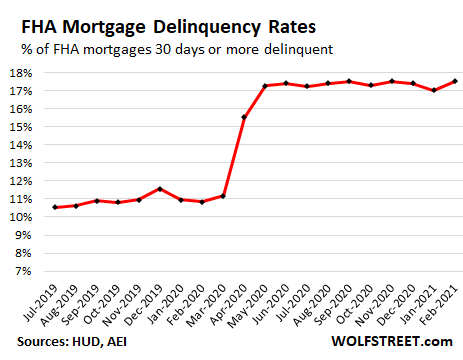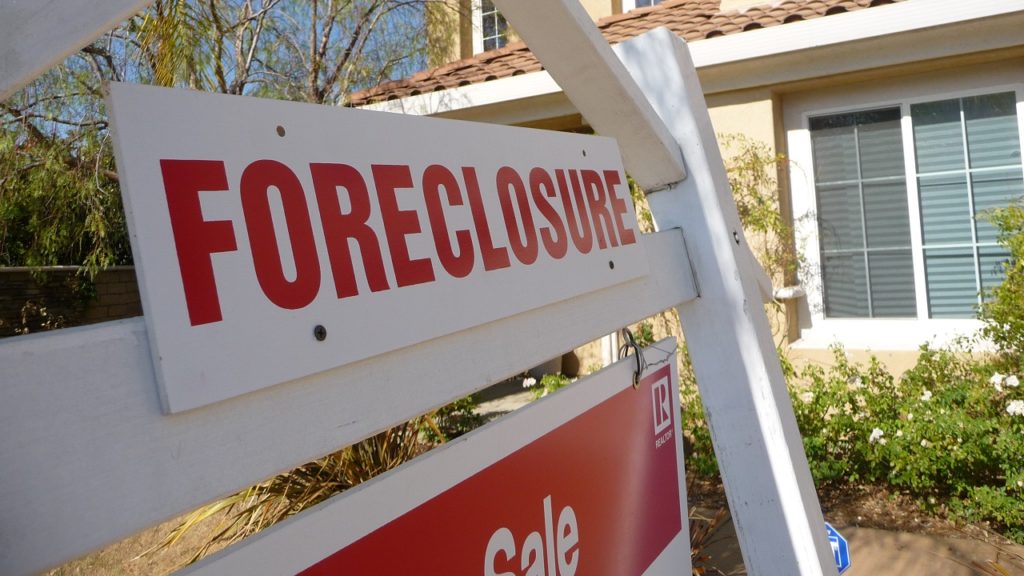Subprime Mortgage Delinquency Still at Record Levels
Despite the “improving economy,” subprime mortgage delinquencies remain at record high levels. And the full extent of the problem is masked by forbearance programs.
The delinquency rate on FHA mortgages spiked to 17.5% in February. That was up from 17.0% in January and equals the all-time record set in September and November of 2020, according to AEI’s Housing Center.
FHA loans categorized as seriously delinquent (90-days or more) jumped from 11.8% in January to 12% last month, setting a new record.

The delinquency rate for the largest 169 Metropolitan Statistical Areas (MSAs) rose to 17.9%. That accounts for about 6 million FHA mortgages. The delinquency rate exceeded 20% in 30 of the largest MSAs. The highest was Nassau County-Suffolk Country, New York, coming in at 24.8%.
Wolfstreet calls it “a historic delinquency problem” that has been fermenting since last spring.
FHA loans always have higher delinquency rates because of the lower lending standards. FHA delinquency rates were rising before the pandemic, but they skyrocketed with the coronavirus and accompanying government lockdowns. A year later, they show no sign of improvement.
In effect, the FHA backstops the subprime mortgage market. According to its website, it’s been helping people become homeowners since 1934 with “low down payments, low closing costs and easy credit qualifying.” The FHA does not make loans. It insures mortgages issued by FHA-approved lenders. FHA-backed loans require lower down payments and lower credit scores than conventional loans. In effect, the federal government assumes the risk of risky loans to low and moderate-income borrowers. The FHA serves as an important backstop in the subprime market.
A FICO credit score below 620 is considered subprime. The FHA makes loans to people with scores well below that number. A borrower with a FICO score of at least 580 can qualify for a loan with just 3.5% down. With a 10% down payment, a borrower can qualify with a credit score as low as 500.
The delinquency rates include borrowers who were behind and then entered a forbearance agreement, allowing them to stay in the home without making mortgage payments. The CARES Act passed last March provided a 6-month forbearance program and it has since been extended multiple times.
In February, the Biden administration extended a foreclosure moratorium for homeowners through June 30, 2021. The executive order also extended the mortgage payment forbearance enrollment window until June 30, and provide up to six months of additional mortgage payment forbearance, in three-month increments, for borrowers who entered forbearance on or before June 30, 2020.
These programs may well get extended further. There is little political appetite to let them expire. But at some point, forbearance will end. Then what?
Those who can resume making payments will either have the missed principle and interest added to the end of the mortgage, or the company will modify the existing agreement. But what about those who can’t resume payments? They will either have to sell the home to pay off the mortgage or the lender will ultimately foreclose. Either way, it means a flood of houses onto the market.
This could be problematic in areas with high concentrations of delinquent mortgages, as WolfStreet explains.
In markets with a large concentration of delinquent FHA mortgages, this would unleash a flood of homes coming on the market – and it would instantly cure, and more than cure, the inventory shortage now being lamented, and when large enough, the sudden supply of homes for sale would send bigger ripple effects through the market. That’s why no one is eager to let the forbearance programs expire, and why it’s so hard to get out of this extend-and-pretend phase.”
If the flood of homes for sale pushes prices down significantly, it could create a situation where the sale of the home doesn’t cover the mortgage – think 2008.
Consider the Houston metro. Currently, 22.5% of FHA mortgages are delinquent. That totals 48,483 homes. Of those, 32,224 are seriously delinquent. And that doesn’t include non-FHA mortgages in delinquency.
If a bunch of these homes suddenly show up on the market, as the floodgates of forbearance open and trigger forced selling, they will put downward pressure across the market, thereby increasing the costs of resolving those mortgages.”
By the way, you – the taxpayer – are on the hook for these mortgages if they go bad.
Juiced by artificially low interest rates (thank you Federal Reserve), the housing market has boomed in recent months. Housing prices have risen rapidly creating a new housing bubble, even as many homeowners struggle to pay their mortgage. As Peter Schiff put it in a podcast last fall, a weak economy is actually driving a strong housing market. As a result, the high subprime delinquency rate hasn’t raised much concern. But there are other factors in play that could pop the housing bubble. Home construction prices are soaring due to the rising cost of raw materials (i.e. inflation – thank you Federal Reserve) and interest rates are pushing up due to inflation fears.
Even if we don’t eventually experience a major financial shock due to people’s inability to pay their mortgages, it should give people convinced that the economy is about to rocket into the stratosphere pause.





 Since Nayib Bukele became president of El Salvador, El Salvador has been in American media and global political discussion more than ever. While much of the attention focuses on Bukele’s mass incarceration of gang members and a decline in homicide of over 70%, Bukele has also drawn attention to his favoritism towards Bitcoin and how he […]
Since Nayib Bukele became president of El Salvador, El Salvador has been in American media and global political discussion more than ever. While much of the attention focuses on Bukele’s mass incarceration of gang members and a decline in homicide of over 70%, Bukele has also drawn attention to his favoritism towards Bitcoin and how he […] With gold hitting yet another awe-inspiring all-time high in the wake of Powell’s remarks reassuring markets (more or less) to expect rate cuts in 2024, a few analysts are pointing out risk factors for a correction — so is there really still room to run?
With gold hitting yet another awe-inspiring all-time high in the wake of Powell’s remarks reassuring markets (more or less) to expect rate cuts in 2024, a few analysts are pointing out risk factors for a correction — so is there really still room to run? Gold hit a new all-time nominal high, surpassing the previous record set in December of the previous year. The precious metal’s price reached approximately $2,140, indicating a robust and continuing interest in gold as a safe-haven asset, despite a rather peculiar lack of fanfare from the media and retail investors. This latest peak in gold […]
Gold hit a new all-time nominal high, surpassing the previous record set in December of the previous year. The precious metal’s price reached approximately $2,140, indicating a robust and continuing interest in gold as a safe-haven asset, despite a rather peculiar lack of fanfare from the media and retail investors. This latest peak in gold […] The gold price has been surging, with unprecedented central bank demand gobbling up supply. It has been a force to behold — especially as US monetary policy has been relatively tight since 2022, and 10-year Treasury yields have rocketed up, which generally puts firm downward pressure on gold against USD.
The gold price has been surging, with unprecedented central bank demand gobbling up supply. It has been a force to behold — especially as US monetary policy has been relatively tight since 2022, and 10-year Treasury yields have rocketed up, which generally puts firm downward pressure on gold against USD.  Total gold demand hit an all-time high in 2023, according to a recent report released by the World Gold Council. Last week, the World Gold Council (WGC) released its Gold Demand Trends report, which tracks developments in the demand for and use of gold around the world. Excluding over-the-counter (OTC) trade, 2023 gold demand fell slightly from 2022 […]
Total gold demand hit an all-time high in 2023, according to a recent report released by the World Gold Council. Last week, the World Gold Council (WGC) released its Gold Demand Trends report, which tracks developments in the demand for and use of gold around the world. Excluding over-the-counter (OTC) trade, 2023 gold demand fell slightly from 2022 […]